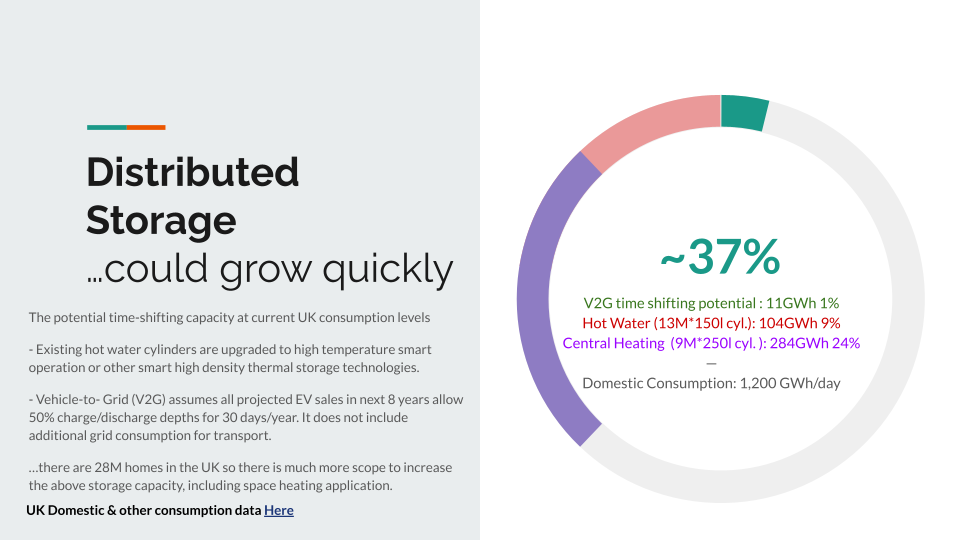Options Here and Now
The amount of carbon emission for a unit of grid electricity production (carbon intensity) varies substantially from week to week as well as on a daily basis. The amount of energy generated also varies during the day to meet demand and is a major factor on carbon intensity when demand exceeds the fluctuating green generation available. The cost of increasing renewable energy capacity increases when its output is regularly curtailed, which adds to the need for more on-demand energy consumption or storage to be made available to the grid.
Octopus Energy’s “Agile” dynamic time of use tariff (below) tracks the resulting effect on wholesale energy energy cost in the UK. This Dynamic Time-of-Use (DToU) tariff gives consumers an opportunity to play a part in helping to balance the grid by guiding and rewarding consumers to use the greenest electricity when it is available and (largely consequently) reduce demand at peak times.
Energy companies may even pay consumers to help balance the grid at “plunge” times. These are times when energy retail companies are penalised when supply is not consumed. However, the availability of DToU tariffs varies from country to country often depending on the way price regulation is applied. By their nature, dynamic expose consumers to increases in wholesale energy costs sooner than long term fixed tariffs, however, they could also be the first to drop in price if they follow wholesale energy costs faithfully.
Time-shifting energy in large quantities and over long periods of time is challenging. There are some grid-scale capacity technologies to store electrical energy generated in low demand periods, but there are scalability issues as well as challenges in solving the problem of grid re-distribution at times of high consumer demand.
A distributed approach over shorter periods of time is however technically achievable with only modest modification and creation of existing heating technologies. Given the large proportion of energy that is required ultimately as heat (or cold) the scalability of this approach is largely already in-place:
Easy Wins?
Heat

Consumer investment in smart technology and upgrades of domestic heating infrastructure can help balance the grid at a scale and at an efficiency beyond that realisable with current grid-scale approaches. However, because this approach requires consumer investment, rather than business investment, the economic incentives of such solutions have substantial commercial and regulatory challenges to overcome before we are likely to see wide-spread adoption.
Medium Power Vampire Devices
Storage of electricity of up to a few kWhs is relatively cheap compared to large batteries required to store an entire house’s power or excess solar. Whether integrated Li-ion (discrete and power dense) or external lead-acid products (e.g. UPS, leisure battery systems,..) are used these can be highly effective ways of minimising grid consumption during short peaks in cost and carbon intensity. At a macro-scale this time-shifting provides huge benefits to balancing the grid with minimal investment for widely used “vampire” products and services such as
- Domestic refrigeration*
- Computing
- Lighting
- Security systems
- Dehumidifiers*
Both manufacturers and consumers can potentially make their products’ consumption much greener with potentially very small additional costs. * In cases such as refrigeration or dehumidification it may not even be necessary to provide any electrical storage as the physical effects can potentially be pre-loaded or deferred before and after periods of high cost and carbon intensity.
A great example of how making a wall socket smart can minimise energy wasted when not in use is measureable energy‘s smart socket.
Incentivisations
For some, the merits of reducing their personal or business carbon footprint is good enough reason to invest in smarter and/or connected technologies. Reducing consumption of the most carbon-intensive grid power consumption also helps enable power generators and grid operators to increase the mix of intermittent energy sources in the network. Grid power carbon intensity is forecast and validated in many countries (e.g. UK) and there are many ways savings in carbon from time-shifting can be reported for businesses and organisations wishing to promote their efforts to decarbonise.
The current energy crisis has derailed many of the financial incentives for adopting time-shifting as a way of saving money, particularly for Dynamic ToU tariffs in some countries. Domestic consumers in the UK are highly buffered from the differential costs of high and low carbon electricity generation as a side effect of the legislative capping of generally increasing costs related to wholesale gas prices. There are currently no easy ways of opting out of this policy as a domestic consumer, though businesses do have more options on sourcing different power provisioning.
Another form of incentivisation is using protocols that have been developed in commercial energy delivery where more sporadic Demand Side Response (DSR) messaging is used to reduce consumption for short periods of time. There are many schemes and technologies that have been used since the earliest days of electricity generation (before digital comms) whereby large consumers can receive near real-time signals to reduce power consumption when requested and in exchange receive a financial reward (or avoid a financial penalty).
DSR can work well for very large grid power consumers if there is sufficient warning and can also help resolve issues of local grid loading, which can be less easy to predict. For DSR to work for domestic consumers an aggregated approach is needed, not least to solve the difficulty in assessing whether single households have responded or not. The aggregated approach requires 3rd-parties to establish commercial relationships with consumers and grid, potentially independently of the consumer’s electricity supplier. It seems unlikely that DSR on its own would be sufficiently widely applicable to balance the entire grid, however it could be particularly effective in managing EV charging as this becomes an increasing factor in grid peak demand profiles. Some counties have already introduced regulatory requirements for interoperability of EV charging systems to support some form of DSR and many EV charging providers are happy to provide API connections to energy distributors. Similarly DSR is better suited to heat pumps as their peak consumption patterns are typically highly common-mode within a geographical region and power reduction for short periods of time can have minimal effects on well insulated space heating.
Some potentially good news is that the UK department for Business, Energy and Industrial Strategy has recently published the UK’s aspirations for smarter energy systems and a proposed Energy Smart Appliances with a focus on DSR over Dynamic ToU tariffs. The technical requirements of this compliance are currently in a very early stages of definitions, but in its current form some areas are already quite overbearing (e.g. IoT security choices) and in quite under-defined in many others such as technical interoperability and commercial structures that would work for providers and consumers.
